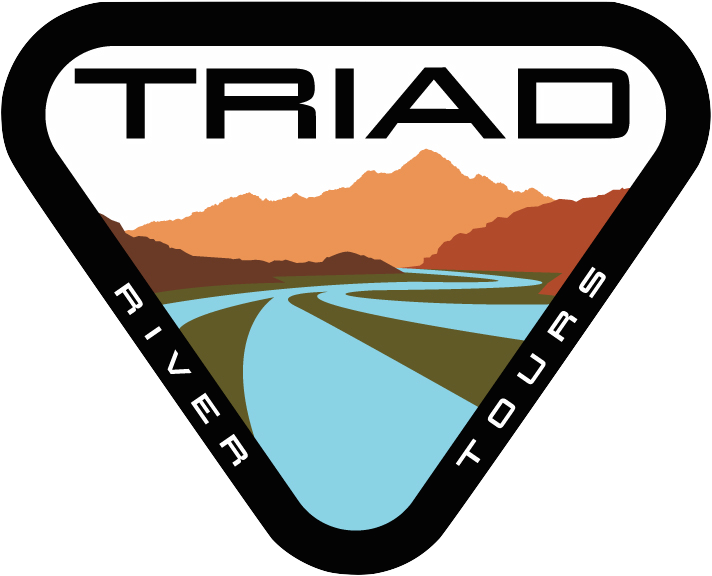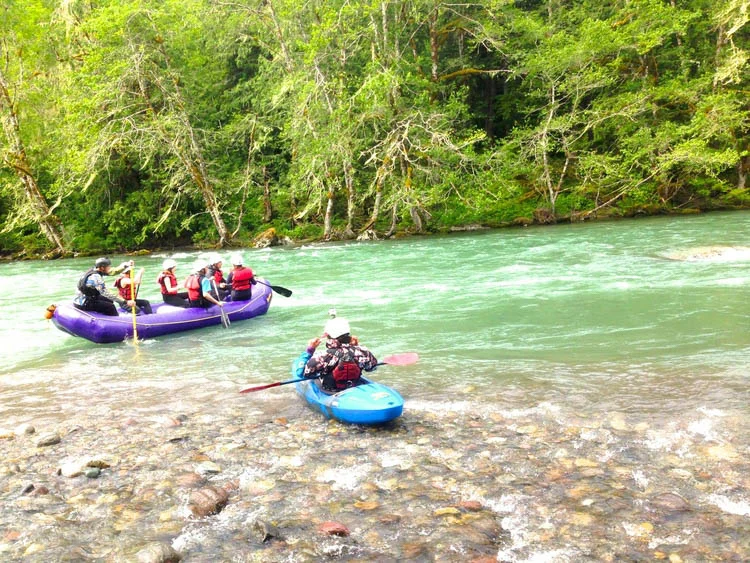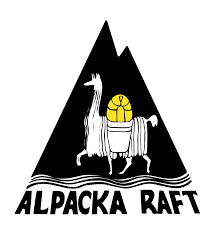Perhaps no debate rages on with more fervor at a campfire surrounded by professional whitewater guides than whether or not a kayak or cataraft is a superior safety boat. There is a clear correlation between guides that kayak and preferring a kayak, and guides that cannot kayak but have extensive rowing skill, and the preference for a cataraft. Which one is the best is mostly subjective, and does often depend on the skill set of the guide themselves, but we’d like to point out some common sense approaches to this situation just in case you’re about to launch a whitewater rafting expedition and have to choose between an adequately trained kayaker and a seasoned oarsperson running a cataraft.
Safety Cat Advantages and Disadvantages
The 14 foot Aire Wave Destroyer is a popular safety cataraft on guided whitewater river rafting trips. Source: http://www.aire.com/aire-cataraft/wave-destroyer-14.asp
Catarafts are above all things, people catchers. The cataraft is at home waiting in a pool below a large rapid, and they are adept at pickup up swimmers before they are lost downriver. For this task, particularly in a commercial setting, the cataraft is the clear winner compared to a kayak. Catarafts have over a thousand pounds of positive buoyancy, and have the ability to get the swimmer completely out of the river; they also have a distinct advantage when it comes to rescuing unconscious swimmers. Overall, the thing to consider with catarafts is how many people you plan on retrieving out of the river; if it’s a high number, and you have a guide that can consistently and safely navigate rapids alone and wait below the trip in the best spot, then the cataraft is the best option, undeniably.
Catarafts are at a distinct disadvantage in almost every other capacity (get it; capacity!?). They are slower than kayaks; and yes, we realize how fast catarafts are for people that are used to being in a raft, but there is absolutely not comparison to a kayak. As a result, if there are swimmers in multiple locations, it will take longer to get to them in a cataract.
Catarafts can carry more equipment, and supplies like a spine board, pin kit, and comprehensive medical kit are much easier to carry on a cataraft than in a kayak. Furthermore, if there is an emergency and a 911 call has to be made, a guide can do so from a cataraft from within the cockpit. While kayakers can keep a cell phone in their PFD, it’s more likely that the evacuation phone and medical kits are stored within the kayaks bulkhead, and thus, the kayaker may need to paddle to shore in order to access them; this could require precious time in an emergency that is not lost when a safety cataraft can simply reach over to the evacuation kit and dial 911, and have a conversation from within the cockpit of the cat.
Catarafts operated by competent and experienced guides also have the advantage of being able to carry a second guide with them, or carry an injured paddler down river. In a case of a raft that was left by rivers edge (perhaps in a case where another guide was injured), catarafts can transport another guide downriver to then meet the abandoned raft. A 14-foot cataraft can carry up to 4 people downriver in class 3 rapids, while a kayak is unable to carry anyone. Catarafts can also carry larger items like hypothermia prevention gear, an extra pump, and in some cases an extra guide.
A major real world downfall of safety catarafts is that they are commonly operated by the lesser-experienced guides, but not always. This is a logical decision commonly made by the trip leader; to put the most accomplished, more experienced guides with the guests or paddlers (in case of a private trip), and the lesser-experienced guide with the cataraft. In this case there are two problems. The first, is that there’s an overwhelming risk being taken by the guide going first through the rapid, and as a result, it may be wisest to have the cataraft run the rapid with the rafts; first, for sure, but still not far enough ahead to provide proper support for the rest of the trip, and certainly not in case of the raft immediately behind the safety cataraft being involved in a flip. Additionally in this instance, it is almost always better, in severe whitewater like Boulder Drop of the Skykomish River, to have the cataraft waiting below the rapid in the spot most likely for swimmers to end up; this allows the cataraft guide the advantage of being able to predict where the swimmers will end up, and get a real birds eye view as the rafts come down as to which swimmer will be, or is in the most dire situation (obviously the safety boater is required to retrieve the swimmer in the most danger first; often this is the furthest down river swimmer). Granted, during scouting, the lead guide can explain to all paddlers where they would be best swimming, but there is absolutely no telling where a swimmer will end up at the bottom of a class 4 rapid. As a result, there is a simple matter of economics at play here that on commercial trips you often necessarily (but not always) have the lesser-experienced guide in the position of a rescue guide.
Catarafts also have the disadvantage of being heavier, and when they flip they can injure the guide. In rare cases, if the cataraft flips (and they will), the guide could lose the boat. If the boat is lost downstream, then the remainder of the trip is going to be run without the safety raft. While this may be rare, we assure you that it has happened many times on commercial rafting trips, and for some reason it happens in the worst rapids and at the worst times. Catarafts are very forgiving, but in big water, with lesser-experienced guides rowing, they can and will flip, and in those cases the proverbial wind can come out of the sails of everyone else in the paddle crew if they witness it. As soon as the cataraft flips below, the attitude and tenor of the rest of the rafting crew changes, and not only are the guests aware that their safety boater has just flipped, but there is a legitimate danger increase to themselves and to the trip as a whole. The demoralizing effect of witnessing a flip is something that many professional whitewater guides have experienced, but many private rafters have not. Within a split second, a paddling crew can go from smiles and laughter to complete and utter despair and fear. If people have never witnessed a raft flip and they see the safety boater flip ahead of them, their psyche immediately, in some cases, goes directly into panic mode, and now you have a team of paddlers that was inexperienced and optimistic, to a team of inexperienced paddlers who are distracted and afraid, and as a result, you have a much less capable paddling crew. While this situation may seem like a detail and a rare exception, the reality is that it’s likelihood is one that has some of the harshest consequences, and in real life situations is more common than it would appear. Safety catarafts come with them many responsibilities, but none as vital as keeping a raft that can flip over easily, right side up.
Kayak Advantages and Disadvantages
The Pyranha Shiva is a popular safety kayak on commercial whitewater river rafting trips. Source: http://www.pyranha.com/kayaks.php?kayak=shiva
Kayaks have several advantages over catarafts, and if you start thinking deeply about it they will start to add up fast. One of them is that a kayak in the hands of an experienced and trained class 5 safety kayaker (like those we have at Triad River Tours) becomes an incredible asset from a preparations standpoint. For example, a legitimate safety kayaker can easily run a class 3 river alone without issue (assuming that they are familiar with it), they can scout the river the day before the guests get there and take video of the rapids so that the other guides can study this video as part of their pre-trip briefing. Kayakers of this kind can be relied upon to navigate a river at over twice the speed as a cataraft. If you ever doubt this just look up YouTube videos of the sickline race, or the North Fork (Kayaking) Championships. Class 5 kayakers are incredibly fast and adept at running intense whitewater, and most class 5 kayakers are highly trained and do not need to scout rapids that may cause a cataraft guide to pull over and scout, wasting precious time in a rescue.
Kayaks are highly mobile. If a safety kayaker does spot a logjam on a scouting run, the kayaker will usually have no problem eventually getting clear of the obstacle. Kayakers are usually self-taught in belaying and getting themselves up and over or around logs or other obstacles using nothing more than a throw rope and a small hand held pin kit. Speaking of pin kits, while kayaks definitely pin, a professional safety kayaker is far less likely to be a liability of any kind when compared to a cataraft. Even a fully competent veteran guide at the oars of a cataraft could pin or wrap their cataraft amidst difficult whitewater, and while this is also possible in a kayak, it is much less common, and the consequences are far less dire.
Kayakers are usually on the river a lot on their days off, and this is a strange and obscure advantage that will not doubt draw the ire of many avid cat boaters, but from the perspective of risk management and overall trends, kayakers are on the river more than rafters or catarafters, and therefore they are more familiar with the sections of river which they run, and they are generally more familiar with their craft (safety kayakers at Triad River Tours are compensated at a rate that considers that they are using their own equipment, while safety catarafts are usually supplied by the company and therefore the guides that use the safety cataraft are less familiar).
Safety kayakers can also flat out run more difficult whitewater. At the end of the day it is true that most of the difficult whitewater in the world that has been kayaked has also been run by an inflatable, but the statistics are astoundingly in favor of kayaks being the undisputed kings of whitewater supremacy. While there may be one or two catarafts that have ran the famed Grand Canyon of the Stikine, there have to date been hundreds of descents done by kayak. Class 5 kayakers seem to feel at home in the worst conditions, whereas catarafters are just not quite in as dominant of a position. As a result there is less risk involved in hiring and utilizing professional safety kayakers in most situations when compared to safety catarafts.
Conclusion
Making a choice between a safety cataraft and a safety kayak should be made with common sense and reason, and should start with the skill set of your crew. If you simply lack a qualified safety kayaker, then you have your answer right there. Also, consider that if you are running a trip that has 4 or 5 rafts, and you are deciding between one of the two, consider that most things you can do in a cataraft you can also do in a raft. Granted, you are having to utilize whoever is in the raft and putting them potentially in danger by involving them in a rescue, but there is no doubt that if you have several rafts and a kayak, you have the ability to perform a wider variety of rescues than if you have several rafts and a cataraft.
The endless debate rages on, but for us at Triad River Tours we always start with our personnel; if we start the day and at the pre-trip meeting we have a competent rescue kayaker, we use them. Hands down that’s our choice if we have the luxury. We know that by choosing a kayaker that there are a couple of situations where we would be better off with a cataraft, and we also know that there is a probability that we could encounter those situations and have a disadvantage as a result of the decision. We also have to account for the quantity and severity of inabilities that catarafts present, and that if we happen upon any one of several river rescue situations where the kayak is preferred, that we will be at a disadvantage. The best thing to do is continually train yourself as a private rafter, or as a professional guide or outfitter try and hire both competent oarspeople as well as great kayakers. If you have the money to spend, make sure to attend an SRT-1 course, preferably by Swiftwater Safety Institute, and if you are planning on working professionally as a safety kayaker, attend on of SSI’s PSK (professional safety kayaker) courses to learn specific skills relevant to safety kayaking. At any rate, the best rescue is one that was done preventatively; keep the bow pointed downstream and when in doubt scout. Catch you on the flip side friends.
Read more:





















